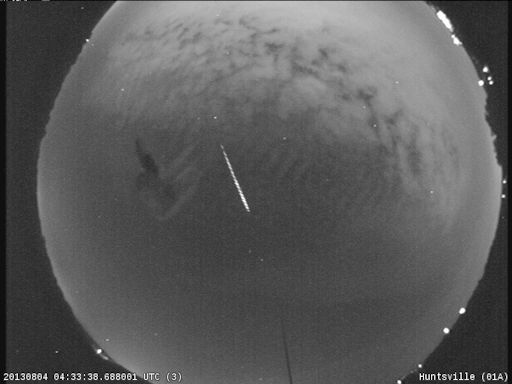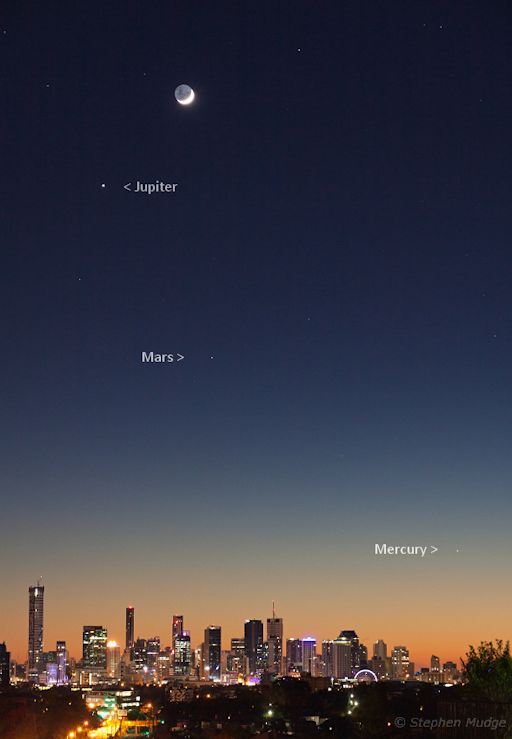GEOMAGNETIC UNREST: A solar wind stream is buffeting Earth's magnetic field, causing minor geomagnetic storms around the poles. High-latitude sky watchers should be alert for auroras. Geomagnetic storm alerts: text, voice.
"I am happy to announce the opening of Aurora Season in Iceland!" says photographer Iurie Belegurschi who snapped this picture on August 5th:
For the first time in months, Northern Lights are penetrating the twilight glow around the Arctic Circle. It's a sign that summer is tilting toward autumn. Says Belegurschi, "everyone is welcome!"
More green could appear among the blue on August 5-6. NOAA forecasters estimate a 50% chance of polar geomagnetic storms as the solar wind continues to blow. Aurora alerts: text, voice.
PERSEID FIREBALLS: Earth is entering a stream of debris from Comet 109P/Swift-Tuttle, source of the annual Perseid meteor shower. Forecasters expect the shower to peak on August 12-14 when Earth transits the densest part of the debris stream. The first Perseid fireballs are, however, arriving now. NASA's All-Sky Fireball Network photographed this one on August 4th:
A fireball is a meteor brighter than Jupiter or Venus. New research from NASA's Meteoroid Environment Office shows that the Perseids produce more fireballs than any other annual meteor shower. That means the nights ahead could be sprinkled with bright flashes.
Meteor rates should remain low for the next few days as Earth penetrates the sparse outskirts of the debris stream, then skyrocket to ~100 Perseids per hour on August 12-13. Got clouds? Listen to the echoes of Perseids and other meteors on SpaceWeather's live meteor radar.
SPACE WEATHER FACT CHECK: Many readers are asking about a report in the Washington Examiner, which states that a Carrington-class solar storm narrowly missed Earth two weeks ago. There was no Carrington-class solar storm two weeks ago. On the contrary, solar activity was low throughout the month of July. The report is erroneous. The possibility of such a storm is, however, worth thinking about: A modern Carrington event would cause significant damage to our high-tech society. Solar flare alerts: text, voice.
MORNING PLANETS: If you wake up before sunrise this week, look east. Three planets are preceding the sun into the dawn sky: Jupiter, Mars, and Mercury. Stephen Mudge photographed the trio (and the visiting crescent Moon) rising over Brisbane, Australia, on August 4th:
"I also created a stack of images taken every three and a half minutes as they rose," says Mudge. "All exposures were 4 seconds with a Canon 50D and 15-85mm lens at f/5.6 and 400 iso."
The crescent Moon has spent the past few mornings planet-hopping from Jupiter to Mars to Mercury. Next up: Venus. The Moon will move past the sun this week and pop up in the evening sky for a loose conjunction with Venus on August 9th and 10th. Browse the gallery for images.

Solar wind
speed: 499.0 km/sec
density: 0.6 protons/cm3
explanation | more data
Updated: Today at 1516 UT
X-ray Solar Flares
6-hr max: B2 1407 UT Aug05
24-hr: B3 0356 UT Aug05
explanation | more data
Updated: Today at: 1500 UT
![]()
Daily Sun: 05 Aug 13
None of these sunspots is actively flaring. Solar activity remains low. Credit: SDO/HMI
![]()
Sunspot number: 75
What is the sunspot number?
Updated 05 Aug 2013
Spotless Days
Current Stretch: 0 days
2013 total: 0 days (0%)
2012 total: 0 days (0%)
2011 total: 2 days (<1%)
2010 total: 51 days (14%)
2009 total: 260 days (71%)
Since 2004: 821 days
Typical Solar Min: 486 days
Update 05 Aug 2013
The Radio Sun
10.7 cm flux: 105 sfu
explanation | more data
Updated 05 Aug 2013
![]()
Current Auroral Oval:
Switch to: Europe, USA, New Zealand, Antarctica
Credit: NOAA/POES
![]()
Planetary K-index
Now: Kp= 2 quiet
24-hr max: Kp= 5 storm
explanation | more data
Interplanetary Mag. Field
Btotal: 5.7 nT
Bz: 2.4 nT south
explanation | more data
Updated: Today at 1516 UT
![]()
Coronal Holes: 05 Aug 13
Earth is inside a stream of solar wind flowing from the indicated coronal hole. Credit: SDO/AIA.







